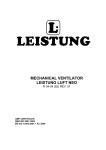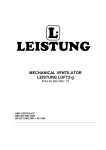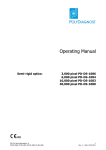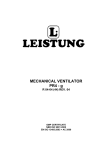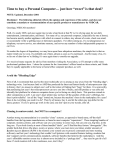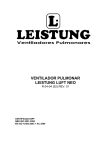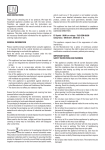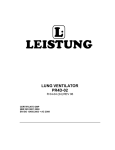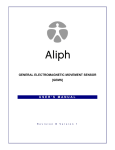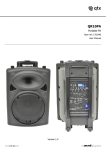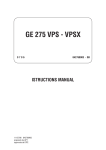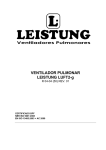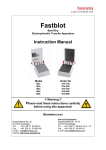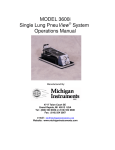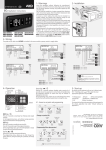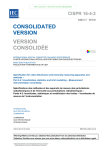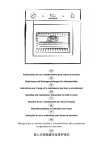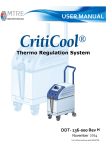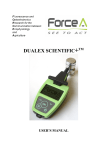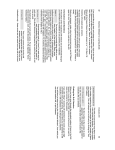Download the manual
Transcript
MECHANICAL VENTILATOR LEISTUNG LUFT1-g R 04-04 (48) REV 01 GMP CERTIFICATE NBR ISO 9001:2008 EN ISO 13485:2003 + AC 2009 MECHANICAL VENTILATOR LEISTUNG LUFT1-G Manufactured by: LEISTUNG EQUIPAMENTOS LTDA. Street: Joao Ropelatto, 202 District: Nereu Ramos City: Jaragua do Sul – SC ZIP 89265-300 Phone: 55 (47) 3371-2741 Fax: 55 (47) 3371-9267 VAT No. 04.187.384/0001-54 I.E: 254.417.108 Op. Auth.: GHL3983MX9H2 GMP Certificate EN ISO 13485:2003 + AC 2009 NBR ISO 9001:2008 Website: www.leistungbrasil.com E-mail: leistung@leistungbrasil.com Legal Responsible: Marcelo Javier Fernandez Technical Responsible: Eng. Fernando Alves Negrao CREA/SC 077160-5 ANVISA registration: Technical Name: Pressure – Volume Lung Ventilator Commercial Name: Mechanical Ventilator Leistung LUFT1-g ANVISA registration No.: 80203470006 - 2 of 63 - R 04-04(48) Rev. 01 MECHANICAL VENTILATOR LEISTUNG LUFT1-G - 3 of 63 - R 04-04(48) Rev. 01 MECHANICAL VENTILATOR LEISTUNG LUFT1-G R 04-04(48) Rev. 01 CONTENTS CONTENTS................................................................................................................. 4 GUIDELINES AND DECLARATIONS OF LEISTUNG EQUIPAMENTO LTDA. ABOUT ELECTROMAGNETIC COMPATIBILITY (EMC) ........................................ 7 CHAPTER 1 – PRESENTATION .............................................................................. 11 PHYSICAL CHARACTERISTICS .......................................................................................... 11 WARNINGS, CAUTIONS AND NOTES .................................................................... 14 WARNINGS ........................................................................................................................... 14 PRECAUTIONS..................................................................................................................... 15 NOTES .................................................................................................................................. 15 CHAPTER 2 – INTRODUCTION............................................................................... 16 PATIEN .................................................................................................................................. 16 TYPE ..................................................................................................................................... 16 VENTILATION ....................................................................................................................... 16 FUNCIONAMENTO DO BLENDER ELETRÔNICO (MISTURADOR AR-O2)........................ 19 ELECTRONIC BLENDER OPERATION (AR-O2 BLENDER) ................................................. 19 FIO2 MEASUREMENT ........................................................................................................... 20 CHAPTER 3 – ASSEMBLY AND CONNECTION .................................................... 21 POWER SOURCE CONNECTION ........................................................................................ 21 GAS SOURCE CONNECTION .............................................................................................. 21 BREATHING CIRCUIT .......................................................................................................... 22 CHAPTER 4 – INDICATORS, CONTROLS AND ALARMS ..................................... 23 FRONT PANEL ..................................................................................................................... 23 INDICATORS ÁREA ............................................................................................................. 23 LCD SCREEN........................................................................................................................ 23 NUMERIC DISPLAYS AND SUPPLYING INDICATORS ...................................................... 25 CONTROL AREAS................................................................................................................ 25 DIRECTIONAL KEYS............................................................................................................ 25 ENTER................................................................................................................................... 25 CHAPTER 5 – LUFT1-G OPERATION ..................................................................... 26 SELECTION SEQUENCE, ADJUSTMENT AND DATA CONFIRMATION........................... 28 - 4 of 63 - MECHANICAL VENTILATOR LEISTUNG LUFT1-G R 04-04(48) Rev. 01 CHAPTER 6 – MENU ............................................................................................... 29 MENU .................................................................................................................................... 29 VENTILATION MODES ......................................................................................................... 29 AUXILIARY FLOWS.............................................................................................................. 29 INSPIRATORY PAUSE ......................................................................................................... 29 EXPIRATORY SENSIBILITY (PSV) ...................................................................................... 29 RESPIRATORY MECHANICS .............................................................................................. 30 AUTO-PEEP .......................................................................................................................... 30 TECHNICAL/OPERATIVE PROFILE .................................................................................... 31 DIRECT ACCESS FUNCTIONS AREA ................................................................................. 32 STAND BY............................................................................................................................. 32 FREEZE IMAGE .................................................................................................................... 32 MANUAL INSPIRATION ....................................................................................................... 32 ALARMS AREA .................................................................................................................... 33 SILENCE ............................................................................................................................... 33 RESET ................................................................................................................................... 33 CHAPTER 7 – VENTILATION MODES – ADULT / PEDIATRIC .............................. 34 VENTILATION MODE SELECTION ...................................................................................... 34 VCV – VENTILAÇÃO CONTROLADA POR VOLUME ......................................................... 34 FIO2 ....................................................................................................................................... 35 FLOW CURVES..................................................................................................................... 35 WAVEFORMS ....................................................................................................................... 35 SQUARE WAVE .................................................................................................................... 35 DESCENDING RAMP WAVE ................................................................................................ 36 INSPIRATORY TIME ............................................................................................................. 36 RESPIRATORY FREQUENCY.............................................................................................. 36 TIDAL VOLUME..................................................................................................................... 37 PEEP ..................................................................................................................................... 37 SENSIBILITY ......................................................................................................................... 37 PCV – PRESSURE CONTROLLED VENTILATION ............................................................. 38 RISE TIME ............................................................................................................................. 39 CONTROLLED PRESSURE.................................................................................................. 39 PSV/CPAP – PRESSURE SUPPORT VENTILATION OR CONTINUOUS POSITIVE PRESSURE ........................................................................................................................... 40 MAXIMUM INSPIRATORY TIME ........................................................................................... 40 SUPPORT PRESSURE ......................................................................................................... 41 SIMV (VCV) + PSV - SYNCHRONIZED INTERMITENT MANDATORY VENTILATION BY PRESSURE WITH PRESSURE SUPPORT .......................................................................... 41 BACK UP VENTILATION ...................................................................................................... 42 VENTILATION MODE............................................................................................................ 42 APNEA TIME ......................................................................................................................... 42 CYCLING VARIABLES .......................................................................................................... 42 PEEP ..................................................................................................................................... 43 CHAPTER 8 – ALARMS ........................................................................................... 44 COLORS AND MEANING OF GRAPHIC INDICATORS........................................................ 44 - 5 of 63 - MECHANICAL VENTILATOR LEISTUNG LUFT1-G R 04-04(48) Rev. 01 ALARMS PRIORITY SEQUENCE......................................................................................... 44 ALARMS DESCRIPTION ...................................................................................................... 44 HIGH INSPIRATORY PRESSURE ........................................................................................ 44 LOW INSPIRATORY PRESSURE ......................................................................................... 45 MAXIMUM EXPIRED TIDAL VOLUME .................................................................................. 45 MINIMUM EXPIRED TIDAL VOLUME ................................................................................... 45 MAXIMUM FREQUENCY ...................................................................................................... 45 APNEA ALARM ..................................................................................................................... 45 PEEP ALARM ........................................................................................................................ 45 LOW GAS PRESSURE.......................................................................................................... 45 POWER OUTAGE ................................................................................................................. 46 LOW BATTERY ..................................................................................................................... 46 MICROPROCESSOR ............................................................................................................ 46 CHAPTER 9 – EXHALATION VALVE AND PATIENT CIRCUIT ............................. 48 CHAPTER 10 – CLEANING, DESINFECTION AND STERILIZATION .................... 51 CHAPTER 11 – MOUNTING THE EQUIPMENT ON THE TROLLEY ...................... 52 ANNEX 1 – SIMBOLOGY ......................................................................................... 53 ANNEX 2 – LUFT1-G ACCESSORIES ..................................................................... 56 ANNEX 3 – PREVENTIVE MAINTENANCE ............................................................. 59 ALARMS SYSTEM INTEGRITY TEST .................................................................................. 60 ANNEX 4 – BLOCK DIAGRAM ................................................................................ 61 ANNEX 5 – WARRANTY .......................................................................................... 62 ANNEX 6 – GLOSSARY ........................................................................................... 63 - 6 of 63 - MECHANICAL VENTILATOR LEISTUNG LUFT1-G R 04-04(48) Rev. 01 GUIDELINES AND DECLARATIONS OF LEISTUNG EQUIPAMENTO LTDA. ABOUT ELECTROMAGNETIC COMPATIBILITY (EMC) Manufacturer guidelines and declarations – Electromagnetic emission The LUFT1-g is designated for use in electromagnetic ambience as specified bellow. It is recommended that the LUFT1-g user ensures it be utilized in such ambience. Emission tests Compliance Electromagnetic ambience - guidelines RF emissions ABNT NBR IEC CISPR11 Group 1 Lung ventilator LUFT1-g utilizes RF energy only for its internal functions. However, its RF emissions are very low and it is improbable it causes any interference with nearby equipments. RF emissions ABNT NBR IEC CISPR11 Class A Harmonic emissions IEC 61000-3-2 Not applicable Emissions due to the fluctuation of voltage flicker IEC 61000-3-3 Not applicable Lung ventilator LUFT1-g is appropriated for all establishments but domestic and may be used in residential establishments and those directly connected to the public low voltage power distribution that supplies edifications for domestic use, since the following warning is attended: Warning: This equipment is designated for use only by health area professional. It may causes radiointerference or interrupts operation of nearby equipments. It may be necessary to adopt mitigation procedure like reorientation or reallocation of the LUFT1-g or blindage of the local. In order to avoid RF interference, the Lung Ventilator LUFT1-g should not be used stacked on others equipment. If this is required, it is recommended to be observed the normal use of equipments. - 7 of 63 - MECHANICAL VENTILATOR LEISTUNG LUFT1-G R 04-04(48) Rev. 01 Manufacturer Guidance and Declaration – Electromagnetic Immunity The Lung Ventilator LUFT1-g is intended for use in environment electromagnetic specified below. It is recommended that the client or user of Lung Ventilator LUFT1-g ensures that it is used in such environment. Electromagnetic Emission tests Test Level Compliance Environment – Guidances Level ABNT NBR IEC 60601 Electrostatic Discharges (ESD) ± 6 kV by contact IEC 61000-4-2 ± 8 kV by air Fast Transient Burst (“Burst”) ± 2 kV at power lines IEC 61000-4-4 Surges IEC 61000-4-5 Power outage, short interruptions and voltage variations on the lines of power input ± 1kV at I/O lines Complies Complies ± 1 kV line(s) to line(s) ± 2 kV line(s) to ground < 5% Ut Complies Floors should be wood, concrete or ceramic. If the floors are covered with synthetic material, relative humidity should be at least 30%. Quality of power supply should be that of a typical commercial or hospital environment. Quality of power supply should be that of a typical commercial or hospital environment. (> 95% voltage drop of Ut) by 0.5 cycles. 40% Ut IEC 61000-4-11 (60% voltage drop of Ut) by 5 cycles. Complies 70% Ut (30% voltage drop of Ut) by 25 cycles. Quality of power supply should be that of a typical commercial or hospital environment. < 5% Ut (> 95% voltage drop of Ut) by 5 seconds. Magnetic fields at power line frequency 3A/m Complies - 8 of 63 - Magnetic fields at power supply frequency should be that of a typical commercial or hospital environment. MECHANICAL VENTILATOR LEISTUNG LUFT1-G R 04-04(48) Rev. 01 Manufacturer Guidance and Declaration – Electromagnetic Immunity The Lung Ventilator LUFT1-g is intended for use in environment electromagnetic specified below. It is recommended that the client or user of Lung Ventilator LUFT1-g ensures that it is used in such environment. Immunity tests Test level ABNT NBR IEC 60601 Compliance level Electromagnetic Environment – Guidance Portable and mobile RF communication equipments must not be used close to any part of the lung ventilator LUFT1-g, including cables, Recommended separation distance (equation with respect to the transmitter frequency: d= 1.17 [ P ] ½ RF Conducted 3 Vrms IEC 61000-4-6 150 kHz up to 80 MHz 3 Vrms d= 1.17 [ P ] ½ 80 MHz up to 800 MHz 3 V/m RF Radiated IEC 61000-4-3 d= 2.33 [ P ] ½ 800 MHz up to 2,5 GHz 3 V/m 80 MHz up to 2,5 GHz Where P is the maximum nominal power output of transmitter, in watts (W), according to transmitter manufacturer, and d is the recommended separation distance, in meters (m). The field intensity established by RF transmitter, as determined by electromagnetic c inspection on the local should be less than D compliance level in each frequency band . Interference may occur around the equipment marked with this symbol: NOTE 1 At 80 MHz and 800 MHz applies the highest range of frequency. NOTE 2 This guidance may be not applicable in all situations. The electromagnetic propagation is affected by absorption and reflection of structures, objects and people. A The field intensity established by fix transmitters, like base transceiver stations, telephone (cellular and wireless), land mobile radio, amateur radio, AM and FM transmitter and TV transmitter, can´t be predicted theoretically with accuracy. To evaluate the electromagnetic environmental due to RF fix transmitters, it is recommended to consider a local electromagnetic inspection. If the local field intensity where the Lung Ventilator LUFT1-g is located exceeds the above applicable RF compliance level, the Lung Ventilator LUFT1-g should be observed in order to verify the normal operation. If an unusual performance is observed, additional procedure may be necessary, such as reorienting or replacement of Lung ventilator LUFT1-g. B Above the frequency range of 150kHz up to 80 MHz, the field intensity must be less than 3 V/m. - 9 of 63 - MECHANICAL VENTILATOR LEISTUNG LUFT1-G R 04-04(48) Rev. 01 Recommended separation distances between portable and mobile RF communication equipment and the Lung Ventilator Luft-NEO The Lung Ventilator LUFT1-g is intended for use in an electromagnetic environment in which irradiated RF disturbances are controlled. The customer or the user of the Lung Ventilator LUFT1-g can help to prevent electromagnetic interference by maintaining a minimum distance between portable and mobile RF communications equipment (transmitters) and the Lung Ventilator LUFT1-g as recommended below, according to the maximum output power of the communication equipments. Rated maximum output power of transmitter (watts) W Separation distance according to frequency of transmitter (meters) m 150 kHz up to 80 MHz d= 1.17 [ P ] ½ 80 MHz up to 800 MHz d= 1.17 [ P ] ½ 800 MHz up to 2.5GHz d= 2.33 [ P ] 0.01 0.12 0.12 0.23 0.1 0.37 0.37 0.74 1 1.17 1.17 2.33 10 3.70 3.70 7.37 100 11.7 11.7 23.3 ½ For transmitters with a maximum rated output power not listed above, the recommended separation distance d in metes (m) can be estimated using the equation applicable to the frequency of the transmitter, where P is the maximum output power rating of the transmitter in watts (W) according to the transmitter manufacturer. NOTE 1 At 80 MHz and 800 MHz, the separation distance for the higher frequency range is applied. NOTE 2 These guidelines may not be applied in all situations. Electromagnetic propagation is affected by absorption and reflection from structures, objects and people. - 10 of 63 - MECHANICAL VENTILATOR LEISTUNG LUFT1-G R 04-04(48) Rev. 01 CHAPTER 1 – PRESENTATION In this User Manual, are presented the necessary information for the correct use of the Lung Ventilator LUFT1-g. The indications relating to enforcement and regulations, mentioned in this manual, is a guideline, the physician should adapt, as their criterion, the needs of patients. GENERAL MODEL LUFT1-G REGISTRY ANVISA Nº: 80203470006 MEDICAL DEVICE CLASSIFICATION CLASS III OPERATION MODE CONTINUOUS OPERATION CLASSIFICATION ACCORDING TO TYPE AGAINST ELECTRICAL SHOCK (INSULATION). CLASS I INTERNALLY ENERGIZED DEVICE CLASSIFICATION ACCORDING TO TYPE OF PROTECTION AGAINST ELECTRICAL SHOCK (APPLIED PART). TYPE B LEVEL OF PROTECTION AGAINST WATER PENETRATION IPX1 EQUIPAMENT NOT SUITABLE FOR USE IN THE PRESENCE OF FLAMMABLE ANESTHETIC MIXTURE WITH AIR, OXYGEN OR NITROUS OXIDE. PHYSICAL CHARACTERISTICS Dimensions (Ventilator without the display) PARAMETERS High Width Depth Weight without accessories Weight with accessories - 11 of 63 - VALUES 290 mm 378 mm 315 mm 9.200 Kg 31.380 kg MECHANICAL VENTILATOR LEISTUNG LUFT1-G EXTERNAL POWER SOURCE 90V – 264V VOLTAGE – CURRENT FREQUENCY POWER FUSE R 04-04(48) Rev. 01 1.5A – 0.50A 47 UP TO 63 HZ 130 VA 250V ~ 2A 20MM SB (SLOW) INTERNAL POWER SOURCE Nominal voltage 12 V Nominal capacity 5.0Ah Type Autonomy Capacity affected by temperature Auto-discharge 68ºF (20ºC) Maximum Discharge Current 77ºF (25ºC) Charge (Constant Voltage) Tempo de Carga (Bateria descarregada) VRLA (Sealed, does not emit gas) Complete battery charge 120 minutes autonomy 77ºF (25ºC) 104ºF (40ºC) 102% 77ºF (25ºC) 100% 32ºF (0ºC) 85% 65% 5ºF (-15ºC) Capacity after 3 months 90% Capacity after 6 months 80% Capacity after 12 months 60% 48A (5s) Floating 77ºF (25ºC) Vmin=10,5V 13.6 – 13.8V / 1.25A (max). 4 Hours Maximum temperature 131ºF (55ºC) Internal fuses 4A 20mm SB SPECIFICATIONS INFORMED BY BATTERY MANUFACTURER. THE INTERNAL BATTERY AND FUSE ARE NOT REPLACEABLE BY OPERATOR. RISK OF ELECTRICAL SHOCK. THE CASE MUST BE REMOVED ONLY BY QUALIFIED PERSONNEL. SWITCHING FOR INTERNALLY BATTERY OCCURS AUTOMATICALLY WITHOUT THE NECESSITY OF EXTERNAL INTERVENTION, IT DOES NOT INTERFERES THE OPERATION OF THE EQUIPMENT BUT TRIGGERS AN ALARM AS EXPLAINED IN CHAPTER 7. - 12 of 63 - MECHANICAL VENTILATOR LEISTUNG LUFT1-G R 04-04(48) Rev. 01 ELECTRICAL OUTPUT VOLTAGE – CURRENT 110V FREQUENCY 0.63A 60 Hz. POWER FUSE 40 VA 250V ~ 0.5A T 20mm SB (Slow) ENVIRONMENTAL SPECIFICATIONS ENVIRONMENT TEMPERATURE OPERATION +10ºC up to 35ºC STORAGE - TRANSPORT +2ºC up to 40ºC (*) 10% up to 95 % No condensable 0% up to 95 % No condensable 66 – 100 kPa OPERATION RELATIVE HUMIDITY STORAGE - TRANSPORT ATMOSPHERIC PRESSURE VALUES OPERATION STORAGE - TRANSPORT 66 – 100 kPa THE MEASURE OF VOLUME AND PRESSURE IS STANDARDIZED BY BAROMETRIC PRESSURE AT SEA LEVEL, BODY TEMPERATURE AND WATER VAPOR SATURATE (BTPS) AND THEY ARE ADJUSTED IN FUNCTION OF ALTITUDE. (*) THE STORAGE OF THE LUNG VENTILATOR FOR LONG PERIODS AT TEMPERATURE GREATER THAN 27ºC, OR WITHOUT ELECTRICAL CONNECTION FOR PERIODS GREATER THAN 2 MONTHS, MAY AFFECT THE INTERNALLY BATTERY LIFE. - 13 of 63 - MECHANICAL VENTILATOR LEISTUNG LUFT1-G R 04-04(48) Rev. 01 WARNINGS, CAUTIONS AND NOTES WARNINGS Constant attention of specialized personnel is required when patient is connected. Whenever the equipment is in use, an alternative ventilation way must be available. Operation problems require immediate corrective action. The alarms do not mean a total safety in case of the equipment be defective. The professional in charge of its use should, using your own criterion and knowledge, adjust the equipment according to the patient needs. Do not use anti-static tubes or electrical conductor in the patient circuit. Do not sterilize the equipment with ethylene oxide. There is a high probability to occur irreversible damage in the ventilator components. The equipment must be connected to AC voltage with protective earth connection The equipment may be affected by High Frequency Electromagnetic Interference (such as cellular, wireless telephone, defibrillators, electro-surgical knifes, magnetic resonance, etc.).Use table of previous section to determine the correct separation distance. The use of accessories and cables other than the specified ones, except accessories and cables furnished by LEISTUNG EQUIPAMENTOS LTDA as spare parts for internal components, may result in EMISSION increasing or IMUNITY reduction of LUFT1-g Before first utilization and after utilization in each patient, it is necessary to clean the ventilator. To sterilize the accessories, follow the instructions on chapter 11. Electrical shock danger: NEVER disassemble the ventilator case In case of problems or difficulties, contact the authorized technical service. The equipment must be supplied by battery when there is doubt about the integrity of ground connector, taking care not to exceed the battery life. - 14 of 63 - MECHANICAL VENTILATOR LEISTUNG LUFT1-G R 04-04(48) Rev. 01 PRECAUTIONS During the warranty period, the stay or movement of equipment should be performed with the original packaging, with its internal correspondent protection, otherwise will result in loss of warranty. Never sterilize the ventilator, the internal components is not compatible with sterilization techniques. Follow the instructions at chapter 11 for equipment cleaning and accessories sterilization. Never operate the equipment exposing it to direct heat or sunlight. Never cover or place the equipment in order to block the air entry for cooling. To ensure electrical protections and avoid risk of fire, never change the fuses. If the equipment does not work, contact the Authorized Technical Support. The improper replacement of the fuses nullifies warranty and represents a risk for the equipment operation, operator and patient safety. NOTES The ventilator is a medical device that has to be operated by qualified and trained personnel, supervised by a doctor. The LUFT1-g is produced with recyclable materials and should not be thrown into common landfills because it contains toxic materials to nature, for this, contact an authorized dealer Electric Diagrams, Circuit Diagrams, component list, repair instructions and training can be provided by Leistung Equipamentos Ltda, by agreement between the parts. Leistung Equipamentos Ltda. is a company of continuous improvement in its products and technical specifications can change without previous notice. - 15 of 63 - MECHANICAL VENTILATOR LEISTUNG LUFT1-G R 04-04(48) Rev. 01 CHAPTER 2 – INTRODUCTION LUFT1-g is among the most complete lung ventilators in the world market, offering a high ventilation quality adapted for each patient, with great ease of operation through an extremely intuitive panel design, which allows the operator to utilize all the parameters using few command keys, due to its intelligent graphical interface, making the work of the operator easier, allowing the operator to provide more attention to the patient. Suitable for pediatric and adult patients, LUFT1-g is able to assume the most complete and rigorous therapies, effectively, reliable and accurate. Based on an easy operative system, it is interactive with the operator, it has fast and safe interconnection system with the patient circuit, avoiding any possibility of error. Its starts with a default configuration, which ensure a safe and accurate ventilation, giving to the operator the control of the equipment and assuring sensitivity values that avoid self-cycling, allowing a better progress of the patient without interferences. Warning messages are very easy to understand which turns possible to take decisions respecting the alarms situation and critical parameters variation.. PATIEN VENTILATION MODES TYPE VENTILATION VOLUME CONTROLLED (VCV) ASSISTED CONTROLLED ADULT PRESSURE CONTROLLED (PCV) AND PRESSURE SUPPORT (PSV) PEDIÁTRIC SPONTANEOUS CONTINUOUS POSITIVE PRESSURE (CPAP) VARIABLES - 16 of 63 - SIMV (VCV) + PSV MECHANICAL VENTILATOR LEISTUNG LUFT1-G R 04-04(48) Rev. 01 SPECIFICATIONS PCV or VCV in adult and pediatric, Emergency ventilation Backup ventilation 21 to 100% (electronically regulated on the panel with graphic display monitoring) 0.1 to 25 seconds 5:1 - 1:99 1 - 180 R.P.M FIO2 Inspiration Time I:E Ratio Ventilator frequency Tidal volume 10 up to 2500 ml BY FLOW: 0.5 up to 10 l/min Sensibility BY PRESSURE: -0.5 up to -15.0 cm H2O (compensated PEEP) 2 up to 70 H2Ocm over PEEP (with adjustable “RISE TIME”) 0 up to 70 H2Ocm over PEEP (with adjustable “RISE TIME”) 2 up to 120 H2Ocm Adjustable from 5% up to 80% of initial flow 0 up to 50 H2Ocm Synchronized in inspiratory phase Synchronized in expiratory phase In VCV mode: automatic adjustment In PCV and PSV modes: up to 180 l/min Up to 120 l/min Pressure Control (PCV) Pressure Support (PSV) Inspiration Pressure Expiration Sensibility PEEP / CPAP Nebulization TGI Inspiratory flow Expiratory Flow Sigh (VCV mode) Inspiratory Pause (VCV mode): Cycles per hour, quantity, volume and maximum pressure. 0 up to 2 seconds with plateau value - In VCV mode: rectangular, descendent ramp, sinusoidal and ascending ramp. - In PCV and PSV: descendent ramp. Flow waveform In case of break of one of them, the equipment continues operating normally. Automatic By pass of the Air-O2 net Adjusted in 120 H2Ocm Inspiratory pressure inner safety valve Regulating pressure valve of air and O2 input STAND BY Internally incorporated into the equipment. To maintain the configuration without cycling. SCALES Automatic actualization for vertical and horizontal analysis. FREEZE For graphics analysis. OUTPUT PARAMETERS AIRWAY PRESSURE: PEAK, PLATEAU, MEAN, BASE(PEEP) I:E RATIO AND SPONTANEOUS BREATHINGS EXHALED TIDAL VOLUME INSPIRATORY PEAK FLOW TOTAL FREQUENCY GRAPHIC INDICATOR OF SPONTANEOUS AND MECHANICAL CYCLES FIO2 CONCENTRATION - 17 of 63 - MECHANICAL VENTILATOR LEISTUNG LUFT1-G R 04-04(48) Rev. 01 BREATHING MECHANICS AUTOPEEP ALARMS INSPIRATORY MAXIMUM/MINIMUM AIRWAY PRESSURE (DISCONNECTION OF THE PATIENT CIRCUIT) MAXIMUM/MINIMUM EXHALED TIDAL VOLUME APNEA WITH ADJUSTABLE TIME MAXIMUM RESPIRATORY FREQUENCY MAXIMUM/MINIMUM PEEP AND CONTINUOUS PRESSURE GAS SUPPLY SOURCE (AIR-O2) POWER OUTAGE LOW BATTERY CHARGE MICROPROCESSOR INTERRUPTED CYCLE IN PRESSURE MODES INVERTED I:E RATIO ALARMS ARE TRIGGERED FOLLOWING PRIORITY ORDER, WITH LIGHT OR SOUND WARNINGS AND/OR SCREEN MESSAGE. GRAPHICS PRESSURE – FLOW / TIME OTHER MENUS MENU OF TIME INDICATION AND EXECUTED SERVICES ALTITUDE ADJUST FOR VOLUME COMPENSATION LANGUAGE SELECTION SELF-TESTS PATIENT CIRCUIT LEAKAGE EXPIRATORY FLOW PEEP VALVE PATIENT CIRCUIT COMPLIANCE PATIENT CIRCUIT TEST (AUTOTEST) IS PERFORMED BY THE OPERATOR WHENEVER THE EQUIPMENT IS TURNED ON. ONCE REALIZED AUTOTEST, THE EQUIPMENT MAKES THE CALIBRATION WITHOUT OPERATOR’S INTERVENTION. WHEN NECESSARY, THE EQUIPMENT CLEANS THE FLOW SENSORS AUTOMATICALLY (EXALATORY VALVE) WITHOUT ITS OPERATION BE INTERRUPTED. IN CASE OF LEAKAGE IN THE CIRCUIT DURING THE INITIAL TEST (AUTOTEST) THE EQUIPMENT SHOWS ON THE DISPLAY A MESSAGE INDICATING THE VALUES OF LEAKING. FOR THE CORRECT OPERATION OF THE EQUIPMENT IT IS IMPORTANT THAT THERE IS NOT ANY LEAKING IN THE PATIENT CIRCUIT. - 18 of 63 - MECHANICAL VENTILATOR LEISTUNG LUFT1-G R 04-04(48) Rev. 01 AT THE EXPIRATORY FLOW TEST THE GAS LINES (AIR AND O2) MUST GIVE A FLOW OF AT LEAST 100 l/min, SO THAT IT DOES NOT INTERFERES WITH ITS OPERATION. IN CASE OF BAD CONNECTION, WRONG ASSEMBLY OR INVERSION OF THE SENSORS, THE EQUIPMENT WILL SHOW AT THE DISPLAY A MESSAGE INDICATING READING ERROR OF FLW AND THE OPERATOR MUST CONFIRM IF HE WILL WORK WITH OR WITHOUT THE EXPIRATORY FLOW READING. WHEN FINISHED THE COMPLIANCE TEST OF THE CIRCUIT THE EQUIPMENT SHOWS ON THE DISPLAY THE VALUES TO BE COMPENSATED AND THE OPERATOR CAN CHOOSE ABOUT COMPENSATE OR NOT THIS VALUE. THE EQUIPMENT WILL COMPENSATE ONLY IF THE OPERATOR CHOOSE YES, OTHERWISE IT WILL NOT DO IT. FUNCIONAMENTO DO BLENDER ELETRÔNICO (MISTURADOR AR-O2) ELECTRONIC BLENDER OPERATION (AR-O2 BLENDER) FiO2 (fraction inspired of oxygen) indicates the quantity of oxygen in the gas inspired by the patient. In general, it may vary from 21% (79% of Nitrogen and 21% of O2) to 100% (pure Oxygen), for example a FiO2 of 60% means that 60% of the inspired volume by patient is oxygen and 40% are composed by nitrogen and other gases. FiO2 in LUFT NEO is generated by an electronic blender system, which dispenses any external device. The mixture is performed by two proportional actuators, known as proportional valve, which has this name due to its function: to control proportionally the flow of air and oxygen that passes through each one of them. Each flow is measured by its respective pneumotachograph (device used for flow measurement) which send to CPU board the current value of the generated flows by the proportional valves. The value of FiO2 is given by the fraction of gas delivered by each proportional valve, where each one of them gets responsible only for one part of the total inspired volume. This system is very accurate, because once the physical quantities are very well known like volume, pressure and flow and the variation of concentration of oxygen in the air are very small as well as the percentage of oxygen 100% provided, is enough that the control calculates the flow value of each value will deliver to patient it is obtained, with a negligible error, the correct FiO2. - 19 of 63 - MECHANICAL VENTILATOR LEISTUNG LUFT1-G R 04-04(48) Rev. 01 FIO2 MEASUREMENT FiO2 measurement is performed through measurement cells furnished along with the equipment. As standard the cell that is included with the equipment is the galvanic oxygen cell which uses electrochemistry reactions for O2 percentage measurement in the inspired gas flow. Due to this characteristic, these cells has life time which starts counting from the moment it is exposed to oxygen in the air, which must be replaced after its determined time. The following figure illustrates the right place to put the cell. As optional, Leistung Equipments Ltd. offers the paramagnetic oxygen cell, which is installed internally in the equipment. The use of paramagnetic cell dispenses the use of galvanic one and also dispenses the periodic replacement, avoiding this additional cost, thus, although it has a price higher than the galvanic one, this difference is compensated in long term. - 20 of 63 - MECHANICAL VENTILATOR LEISTUNG LUFT1-G R 04-04(48) Rev. 01 CHAPTER 3 – ASSEMBLY AND CONNECTION POWER SOURCE CONNECTION The electrical connection is located in the back of the case. In its case there are indicated the voltage values of operation along with the current ones and nominal power of the equipment. There is also indicated the corresponding fuse values. THE EQUIPMENT HAS INCLUDED FROM FACTORY FUSES OF 2A 20mm SB SLOW ABLE TO 90V UP TO 264V~ THE ELECTRICAL CHARACTERISTICS OF THE EQUIPMENT IS FOUND IN THE CHAPTER 1 OF THIS MANUAL THE SUPPLY INPUT IS UNIVERSAL. THE EQUIPMENT WORKS IN WHOLE VOLTAGE RANGE (90V UP TO 264V) WITHOUT OPERATOR’S INTERVENTION EVEN WHEN THERE IS A VOLTAGE REDUCTION OF THE POWER DURING THE NORMAL OPERATION. CERTIFY THAT THE CONNECTION OF THE EQUIPMENT IS REALIZED WITH A GROUNDED PLUG TO ASSURE ITS CORRECT OPERATION. NEVER START THE EQUIPMENT WITHOUT GROUND CONNECTION. THE ELECTRICAL INSTALLATION WHERE THE EQUIPMENT WILL BE PLACED MUST BE IN COMPLIANCE WITH THE NBR 13534 STANDARD, WHICH DETERMINES THE MINIMAL CONDITIONS OF ELECTRICAL INSTALATION IN HEALTH CARE STABLISHMENTS. GAS SOURCE CONNECTION The gas connection source is located at the back of the case. In its case are indicated corresponding inputs of air and oxygen. AIR INPUT Male connector DISS ¾” –16 OXYGEN INPUT Male connector DISS 9/16”-18 - 21 of 63 - MECHANICAL VENTILATOR LEISTUNG LUFT1-G R 04-04(48) Rev. 01 AT THE PRESSURE TIP TUBES ARE UTILIZED THE FEMALE CORRESPONDING CONNECTORS. THE SCREWABLE CONNECTIONS USED IN THE AIR INPUTS ARE ACCORDING WITH NBR 11906 STANDARD, WHICH DETERMINES THE MINIMAL CONDITIONS FOR THIS TYPE OF CONNECTION. THE AIR AND OXYGEN INPUTS OF THE EQUIPMENT ARE MADE WITH VALVES THAT PREVENT REVERSE FLOW OF GASES THROUGH THE INPUT PORTS AND THE CROSSFLOW OF GASES. INPUT PRESSURE AIR 2.8 up to 6 kg/cm2 OXYGEN 2.8 up to 6 kg/cm2 MINIMUM FLOW SUPPLY 60 l/min. MAXIMUM FLOW 180 l/min. DO NOT USE THE EQUIPMENT IN PRESENCE OF ANESTHESIC INFLAMMABLE GASES. EXPLOSION AND/OR FIRE DANGER. IT MUST BE USED AIR AND OXYGEN COMPRESSED, CLEAN AND DRY IN ORDER TO AVOID CONTAMINATION THAT AFFECTS THE EQUIPMENT AND MAY GENERATE A BAD OPERATION. IN CASE OF MISSING OF ONE OF THE GAS SUPPLY (AIR OR O2) THE EQUIPMENT CONTINUES OPERATING NORMALLY WITH THE OTHER GAS SUPPLY. LUFT1-G SUPPORTS INLET PRESSURE UP TO 1000 KPA (10.2 KG/CM2), AVOIDING THE USE OF EXTERNAL PRESSURE REGULATORS UNTILL THIS VALUE. BREATHING CIRCUIT UTILIZE RESPIRATORY CIRCUIT AS THE NECESSITY: PEDIATRIC OR ADULT. THE DIFFERENCE IS IN THE TUBES DIAMETER. IN RESPIRATORY CIRCUITS WHICH HAVE WATER DRAIN IN ITS BRANCHS (INSPIRATORY/EXPIRATORY), VERIFY THE HEMERTICITY TO AVOID VOLUME LEAKAGE IN THE CIRCUIT. WHEN THE CALIBRATION OF THE PATIENT CIRCUIT IS PERFORMED, THE NEBULIZER MUST NOT BE CONNECTED IN IT. VERIFY THE CORRECT POSITION OF THE DIAPHRAGM OF THE EXALATORY VALVE. SEE CHAPTER 8. THE CONNECTORS OF THE PATIENT CIRCUIT ARE CONICAL TYPES (22mm IN ADULT AND THEY ARE ACCORDING WITH THE ISO 5356-1(NBR13475) STANDARD, WHICH DETERMINES THE MINIMAL EXIGIBLE CONDITIONS FOR THESE CONNECTOR TYPES. - 22 of 63 - MECHANICAL VENTILATOR LEISTUNG LUFT1-G R 04-04(48) Rev. 01 CHAPTER 4 – INDICATORS, CONTROLS AND ALARMS FRONT PANEL INDICATORS AREA LEISTUNG LUFT1-g counts with a double monitoring system with graphic and numeric indications. LCD SCREEN Color LCD screen shows the selected values, curves and resultant values. The screen has an information distribution so that permits to the operator a fast localization of the data to be read, offering so a high operability. - 23 of 63 - MECHANICAL VENTILATOR LEISTUNG LUFT1-G R 04-04(48) Rev. 01 Seeking a greater ease and speed in handling, the 17-inches LCD display is organized in areas: alarm area, monitoring area, configuration area and the graphs areas where all these information are evidenced with different colors. All values in white color are possible to be adjusted through the operator’s adjustments, the resultant values cannot be adjusted and they are in yellow. The alarm values are red colored giving to the operator a greater ease of configuration. In alarms area there are the alarms of: maximum pressure, minimum pressure, maximum volume, minimum volume, maximum frequency, as well as their resultant values. In monitoring area it is possible to view the numeric values of peak pressure, mean pressure and base pressure as well as inspiratory peak flow, inspiratory time, I:E ratio and FIO2. On the bottom of the display are the parameters adjustable by the operator, such as: FIO2, WAVEFORM, RISE TIME, INSPIRATORY TIME, FREQUENCY, TIDAL VOLUME, CONTROL PRESSURE, SUPPORT PRESSURE, PEEP and SENSIBILITY. To change the values, the operator must select the desired option, press ENTER, adjust the value and confirm it pressing ENTER again. In sensibility option, the operator may choose for work with SENSIBILITY BY FLOW (l/m) or PRESSURE (H2Ocm); to change option go in sensibility and press ENTER then confirm the change with the side keys (right/left) changing from l/m to H2Ocm, and the directional keys (up/down), ranging work values. Resultant values that remain in yellow and are located in monitoring area are not adjustable, they are resultant parameters of the adjustable ones, i.e. the values measured by the equipment. Ex: peak pressure, base pressure and mean pressure in airways, exhaled tidal volume, frequency, flow peak, inspiratory time, I:E ratio and FIO2 monitoring. - 24 of 63 - MECHANICAL VENTILATOR LEISTUNG LUFT1-G R 04-04(48) Rev. 01 On the upper side of the screen is indicated: 1 – Upper left side – Company’s name and equipment model, below there are the patient type and ventilation mode (see chapters 5 and 6). 2 – Upper right side – Date and hour the equipment was started, below there are current date and hour of the equipment. NUMERIC DISPLAYS AND SUPPLYING INDICATORS LEISTUNG LUFT1-g counts with a set of numeric displays which show the values of pressures (peak and base), expired volume and frequency, for the case of failure in the graphic display or visualization at distance. The maximum sampling error is ±10%. LEISTUNG LUFT1-g counts with an indicator of the type of power source (external “110-220V~” or internal “Battery”) which the equipment is using. Whenever the “110220V~” indicator is turned on, the internal battery is being recharged. ALL MEASURES USED AND SHOWN BY THE EQUIPMENT ARE EXPRESSED FOR AMBIENT TEMPERATURE AND DRY PRESSURE (ATDP). CONTROL AREAS In this sector there are the keys that permit to select, adjust and confirm of data, and also the access to options selection by screen menu. DIRECTIONAL KEYS Directional keys permit to move the selection cursors of menus and parameters. Also is utilized for adjustment of the selected parameters. ENTER When the parameters are selected, activates adjustment mode and realize the values confirmation. It is also utilized to activate menu options. - 25 of 63 - MECHANICAL VENTILATOR LEISTUNG LUFT1-G R 04-04(48) Rev. 01 CHAPTER 5 – LUFT1-G OPERATION When starting the equipment, an initialization sequence is performed which includes memory test, internal battery, indicator LEDs etc. Finished the initial sequence, the categories to be ventilated are shown to be selected according to type of patient: ADULT PEDIATRIC THIS SELECTION INFLUENCES THE OPTIONS OF THE OFFERED VENTILATION MODES AND THE INITIAL PARAMETER VALUES OF OPERATION. IS CONSIDERED: - ADULT: PATIENTS WITH MORE THAN 30 KG OF WEIGHT. - PEDIATRIC: PATIENTS BETWEEN 10 AND 30 KG OF WEIGHT. - 26 of 63 - MECHANICAL VENTILATOR LEISTUNG LUFT1-G R 04-04(48) Rev. 01 Following is performed a test of the patient circuit. It is necessary to install the circuit and maintain blocked the Y output during the entire test. In this test is verified if there is leakage, it measures and compensates the circuit compliance and is verified the PEEP control and exhalation valve flow. THE INCORRECT OBSTRUCTION OF THE PATIENT OUTPUT MAY RESULT IN LEAKAGE ON THE SYSTEM. IF THE EXHALATION VALVE IS ASSEMBLED INCORRECTLY OR WITHOUT ITS READING INTERNAL MEMBRANE (INTERNAL MAILER), THE EQUIPMENT WILL NOT BE ABLE TO READ THE EXHALATED VOLUME, WHERE THE OPERATOR MAY OPT TO WORK WITHOUT THIS READING OR RESTART THE TEST. Finally is accessed the operative modes menu. The mode is chosen by the selection keys (up and down). Confirmation of the selection is done through pressing ENTER and will show on the screen the necessary parameters for its use. - 27 of 63 - MECHANICAL VENTILATOR LEISTUNG LUFT1-G R 04-04(48) Rev. 01 SELECTION SEQUENCE, ADJUSTMENT AND DATA CONFIRMATION Using the selection keys, the parameters to be selected can be accessed. When selected the option, pressing ENTER the parameter has its color changed permitting its configuration by the vertical and horizontal keys. To finish, press again ENTER to confirm, change can be canceled by pressing RESET. Change is also canceled if the parameter remains selected for more than 5 seconds or without any modification Is made in its value. Is worth noting that the adjustments made in parameters will not be activated until the mode configuration is finished and the ventilation is started through pressing Manual inspiration key. ONCE CONFIRMED THE VALUES, THE ACTION CAN NOT BE UNDONE. ALWAYS CHECK THE MODIFIED VALUES BEFORE CONFIRMING. - 28 of 63 - MECHANICAL VENTILATOR LEISTUNG LUFT1-G R 04-04(48) Rev. 01 CHAPTER 6 – MENU MENU Pressing MENU, it will show in the right side of the LCD display the following options: VENTILATION MODES A list of operative modes according to the type of selected patient (Adult or Pediatric) is shown when the equipment is started. Select the required mode using the directional keys and press ENTER, immediately it will be shown on the display the values of the new mode to be applied and confirm the change pressing MANUAL INSPIRATION. While the change is not confirmed, the equipment will keep working under the adjustments done before. To see the operative modes which this equipment counts with, see chapter 6. LUFT1-G NEVER STOPS OPERATING DURING CHANGES OF OPERATIVE MODES. IN CASE OF CANCELING CHANGES, JUST PRESS RESET TO DENY ALL THE CHANGING PROCESS. AUXILIARY FLOWS Pressing MENU, select the AUXILIARY FLOWS option, in this menu it is possible to activate the auxiliary flows outputs, which are: NEBULIZER: Selecting this option the operator can adjust the time of exit of FIO2 for nebulization, synchronized with inspiration time, this time may be 5, 10, 15 or 20 minutes, according to the necessity. This output is deactivated automatically at the end of the adjusted time, or manually setting zero the time in menu. IN VOLUME LIMITED MODES, THE VOLUME AT THE PATIENT OUTPUT IS REDUCED TO COMPENSATE THE VOLUME AGGREGATED BY NEBULIZES FLOW. TGI: Selecting this option the operator may activate the output flow of tracheal gas insufflations (TGI) synchronized with expiratory time. To deactivate it is necessary to access the menu manually. INSPIRATORY PAUSE Pressing MENU key, select Inspiratory Pause option. Inspiratory pause is a brief pause (0.10 - 2.00 seconds) at the end of inspiration, during which the pressure remains constant and the flow is zero. To deactivate it, access again Inspiratory Pause and set to “0”. EXPIRATORY SENSIBILITY (PSV) In PSV and combined modes which include support pressure, it is possible to adjust the flow value which performs the changing between inspiration phase and exhalation phase (cycle). It is expressed in percentage of the inspiratory flow peak and may be adjusted between 5% and 80%. The flow has descending ramp waveform and when the flow crosses the selected input it produces the cycle. The smaller value will allow the inspiration time to be increased, while the higher value shorten the inspiratory time. - 29 of 63 - MECHANICAL VENTILATOR LEISTUNG LUFT1-G R 04-04(48) Rev. 01 IF THERE IS LEAKAGE IN THE PATIENT CIRCUIT, A LOW VALUE OF EXPIRATORY SENSIBILITY MAY HAMPER THE CYCLE, DUE TO THE LEAKAGE BE GREATER THAN THE SELECTED INPUT VALUE. RESPIRATORY MECHANICS Press MENU key and select Respiratory Mechanics option. AUTO-PEEP Auto-PEEP is conceptualized as the persistence of an alveolar positive pressure at the end of exhalation, non intentional, due to the presence of a final exhalation lung volume bigger than the previewed residual functional capacity. It occurs in patients submitted to mechanical ventilation, in consequence of starting an inspiratory phase with positive pressure, before the expiratory time is enough to a complete exhalation of the inspired volume previously. Auto-PEEP is not evident, may changes drastically the alveolar dynamic and generates a considerable risk in situation that affects the flow during expiration, leading to unnecessary increasing of the respiratory system mechanical work. To request Auto-PEEP measurement just press MENU key, select Respiratory Mechanics option and access Auto-PEEP window. Upon selecting Auto-PEEP window, LUFT1-g starts measuring it and shows on the screen the following message: When measurement procedure and calculus of Auto-PEEP is concluded, LUFT1-g shows on the upper part of the screen the value of the TOTAL PEEP, Auto-PEEP and PEEP. - 30 of 63 - MECHANICAL VENTILATOR LEISTUNG LUFT1-G R 04-04(48) Rev. 01 TECHNICAL/OPERATIVE PROFILE Within technical/operative profile are found the options: Maintenance, Language, Sighs, Hour/Date and PEEP alarm. MAINTENANCE: In this option are visualized the hours of use of the equipment, as well as the hours of use and date corresponding to the maintenance done described in annex 3. LANGUAGE: Enables the operator to choose among the languages: ENGLISH, PORTUGUESE and SPANISH. IT IS IMPORTANT TO REMIND THAT TO CHANGE THE LANGUAGE, THE EQUIPMENT MUST BE RESTARTED. SIGHS: This option permits to configure: Quantity of sighs: quantity of consecutive sighs (1 up to 3) performed in each cycle. Cycles per hour: quantity of times (5, 10, 15, 20) the sigh cycles will be repeated per hour. Volume: amount of additional volume (it will be added with the already set volume) which will be given by the ventilator in each sigh. Maximum pressure: During sighs this value is taken as reference for activation of maximum alarm. PEEP ALARM: In this option is permitted the modification of PEEP alarm values. The operator can choose to work among the limits of 2, 4, 6, 8, 10 H2Ocm. ALTITUDE COMPENSATION: To adjust height related to sea level where the equipment is being used. CIRCUIT TEST: It must be done when the patient circuit is replaced or changed in the initial line test. TO PERFORM THIS TEST THE VENTILATOR MUST BE IN STAND BY. THE ALARM WILL BE ACTIVATED ALLWAYS THE PRESSURE IS BELOW OR ABOVE THE FIXED VALUE OF PEEP, BEING ITS ACTUATION IMMEDIATE OR THROUGH PRIORITIES WITH AS MAXIMUM THE TIME OF 5 SECONDS. - 31 of 63 - MECHANICAL VENTILATOR LEISTUNG LUFT1-G R 04-04(48) Rev. 01 DIRECT ACCESS FUNCTIONS AREA The area of direct access keys includes the keys more frequently used, allowing a fast and easy access. These keys are: STAND BY FREEZE IMAGE MANUAL INSPIRATION STAND BY Permits to select Stand by mode, which maintains the ventilator in state of repose without alarms until it gets connected to the patient again, without losing the previous set operation parameters. WHILE IN STAND BY, ALL THE KEYS ARE LOCKED, EXCEPT MANUAL INSPIRATION KEY. FREEZE IMAGE Freezes the graphs currently shown on screen, maintaining active patient monitoring and updating output values and airway pressure bar. MANUAL INSPIRATION Each time this key is pressed, a new inspiratory cycle is started. It is only active at expiratory phase. - 32 of 63 - MECHANICAL VENTILATOR LEISTUNG LUFT1-G R 04-04(48) Rev. 01 ALARMS AREA In this sector are the light indicators corresponding to the alarms, which when activated are followed by an alert sound and by messages on screen. The light indicators turns on intermittently to indicate which alarm is activated, once solved the cause of the alarm, the indicator will remain turned on permanently to indicate which alarm was triggered, until the key RESET be pressed. All the triggered alarms are registered with hour and date at the menu Alarms History (See MENU key). SILENCE This key is used to silence the alarm, without affect the light indicators, during a time of 1 minute. If at the end of this time the cause of the alarm was not solved, the sound will get started again. RESET This key is used to nullify all the light and sound alarm indicators and it is maintained until any alarm is activated. - 33 of 63 - MECHANICAL VENTILATOR LEISTUNG LUFT1-G R 04-04(48) Rev. 01 CHAPTER 7 – VENTILATION MODES – ADULT / PEDIATRIC VENTILATION MODE SELECTION Pressing Menu key, main menu is accessed. The first option is for ventilation modes. Pressing ENTER, a list containing all the usual modes for the selected category is shown. The vertical and horizontal selection keys allow selecting the desired mode. When confirmed the mode by pressing ENTER, are shown on the screen all the parameters related with the selected mode. If the ventilator are at this moment ventilating a patient through another mode, the changes are not concluded until manual inspiration key is pressed, which permits to finish the previous mode and start a new one. Pressing RESET, all the changes are canceled and the previous mode is resumed. Following there are brief descriptions of the ventilation modes. VCV – VENTILAÇÃO CONTROLADA POR VOLUME In VCV mode, LUFT1-g integrates the air flow with inspiration time and delivers to patient the programmed current volume. Therefore, VCV is flow limited and volume cycled. To perform flow changes the operator must change the current volume, flow waveform or inspiratory time according to necessity, i.e. the flow delivered by the equipment is the resultant of current volume, inspiratory time and flow waveform requested by the operator. - 34 of 63 - MECHANICAL VENTILATOR LEISTUNG LUFT1-G R 04-04(48) Rev. 01 The resultant pressure is free and depends exclusively on physical and mechanical conditions of the respiratory system. VCV is an assisted/controlled ventilation mode and its inspiratory cycles may be triggered by time, flow or pressure. In this mode the following variables must be adjusted: FiO2; Flow curve (Wave); Inspiratory time (T. Ins); Respiratory frequency (Freq); Tidal volume (VTidal); PEEP; Sensibility (Sens); FIO2 FiO2 is related to the fraction of oxygen inspired by the patient. To modify FiO2 just select its window with ENTER and adjust the fraction between 21 and 100%. FLOW CURVES LUFT1-g provides square and descending ramp flow waves. Flow waves may be selected in volume controlled modes. Flow waves can be selected in volume control modes. WAVEFORMS The initial work waveform in volume modes is always square and to change it, you must access “WAVEFORM” in the bottom left corner of the screen, press ENTER, choose the requested waveform and confirm with ENTER. The waveform is changed in the first cycle. There are two common wave patterns: SQUARE WAVE With this adjustment, the flow accelerates very fast and reaches a flow value which will be maintained during inspiration. This wave pattern permits an appropriate I:E ratio with a normal torrential. If the airway peak pressure of the patient is higher than the normal, the patient feels uncomfortable, the wave pattern can be inverted in order to decrease this pressure or to accommodate a more normal breathing pattern. When the flow pattern is square, the volume has a ramp wave and the pressure is a scale followed by a ramp. - 35 of 63 - MECHANICAL VENTILATOR LEISTUNG LUFT1-G R 04-04(48) Rev. 01 DESCENDING RAMP WAVE This waveform uses a fast flow acceleration followed by a slow climbdown. This waveform may request very high flows to obtain an appropriate I:E ratio. This wave may be used to provide a better distribution of inspired air. INSPIRATORY TIME The inspiratory time correspond to the orange color on the graph above. Integrated to current volume, the inspiratory time works as a flow controller, volume cycled, furthermore, to perform changes in the velocity of the inspiratory flow the operator must change the variables: inspiratory time and current volume. RESPIRATORY FREQUENCY Refers to ventilation cycles quantity given by LUFT1-g to patient within the period of one minute. - 36 of 63 - MECHANICAL VENTILATOR LEISTUNG LUFT1-G R 04-04(48) Rev. 01 TIDAL VOLUME Tidal volume (V Tidal) represents the volume in liters delivered to patient in each ventilation cycle. PEEP PEEP (Positive End-Expiratory Pressure) is a tool used to recruit and maintain the alveoli open, besides optimizing gases exchanges and to combat lung shunts. SOME PATHOLOGIES REQUIRE SPECIFIC PEEP VALUES TO RECRUIT THE ALVEOLI WITHOUT DAMAGING THEM. THE USE OF PEEP GENERATES HEMODYNAMIC REPERCUSSIONS THAT MUST BE KNOWN BY THE OPERATOR SENSIBILITY During artificial ventilation, a pre determined trigger variable must be reached to initiate the inspiration. In VCV the ventilation may be controlled by time, i.e. by respiratory frequency, or controlled by the patient himself who triggers the cycles as his necessity. In LUFT1-g the sensibility trigger is by pressure or flow. The ventilator detects a drop in pressure or flow threshold, which is produced by the patient effort in his airway. The inspiration may be triggered if performed effort exceeds the pressure of flow threshold selected to sensibility. - 37 of 63 - MECHANICAL VENTILATOR LEISTUNG LUFT1-G R 04-04(48) Rev. 01 The pressure or flow threshold is determined by the operator in the ventilator, which always indicates the negative pressure under PEEP or the displaced flow in the circuit necessary to trigger the ventilator. When the sensibility limit is reached the inspiratory valve is open and a new cycle starts. To choose the numeric value of the sensibility just select its window and move the cursor on the vertical direction. When the presented is with negative signal and unit of measure cmH2O it means the sensibility is adjusted by pressure and when it is with unit of measure L/min it means it is adjusted by flow. To change this configuration just access its window and move the cursor on horizontal direction. PCV – PRESSURE CONTROLLED VENTILATION In PCV the LUFT1-g delivers to patient the adjusted pressure, the inspiratory flow is automatically adjusted to maintain the pressure constant during the adjusted inspiratory time. Therefore, PCV is pressure limited and time cycled. IN PRESSURE MODES THE FLOW WAVEFORM CAN NOT BE CHANGED, WHICH WILL BE ALWAYS DESCENDING RAMP. The resultant volume is free and depends only on physical and mechanical conditions of the respiratory system. PCV is an assisted/controlled ventilation mode and the inspiratory cycles may be triggered by time, flow or pressure. In this ventilation mode the following variables must be adjusted: FiO2 - 38 of 63 - MECHANICAL VENTILATOR LEISTUNG LUFT1-G R 04-04(48) Rev. 01 Rise Time (R. Time); Inspiratory time (T. Ins); Respiratory frequency (Freq); Controlled pressure (P Con); PEEP; Sensibility (Sens). RISE TIME Rise Time is the time the ventilator requires reaching the selected pressure. Increase or decrease this time may assist in the comfort of the patient. In LUFT1-g the Rise Time is modulated by flow, i.e. the higher the rise time, the shorter the time to reach the adjusted pressure and the shorter the rise time, the longer the time to reach the selected pressure. For appropriate ventilation, the rise time must be adjusted in order to provide the smallest overshoot possible. IF DURING A MANDATORY OR SPONTANEOUS CYCLE THE EQUIPMENT DETECTS ANY VARIATION OF FLOW GENERATING A PRESSURE VALUE HIGHER THAN THE DETERMINED THE ALARM OF INTERRUPTED CYCLE IS ACTIVATED AND LIMITS THE PEAK PRESSURE VALUE. THE CAUSE OF THIS ALARM MAY BE CORRECTED THROUGH SENSIBILITY OR RISE TIME ADJUSTMENT. CONTROLLED PRESSURE In PCV, the airway pressure level is the main parameter to be adjusted, because it will have a direct influence over the tidal volume available for the patient. To adjust the controlled pressure you must remind that “P.Con” adjustment refers to pressure value over established value for PEEP. - 39 of 63 - MECHANICAL VENTILATOR LEISTUNG LUFT1-G R 04-04(48) Rev. 01 PSV/CPAP – PRESSURE SUPPORT VENTILATION OR CONTINUOUS POSITIVE PRESSURE Spontaneous ventilation mode triggered by flow or pressure through patient effort. In this mode the ventilator supports the patient through maintaining a positive pressure adjusted in “P Sup” window. This maintains free to patient to control the respiratory frequency, inspiratory time and inspired air volume. Therefore, the tidal volume depends on inspiratory effort, pre established support pressure and the mechanics of the respiratory system. To perform this function, the ventilator, upon starting, increases the pressure in the circuit to a defined pressure support level. The end of the inspiration occurs when the inspiratory flow, upon reduction, reaches a pre determined value called expiratory sensibility. Expiratory sensibility is adjusted in MENU “Expiratory Sensibility”, and its variation may be adjusted with values between 5 and 80% of the inspiratory peak flow. The control variable in this mode is P Sup (support pressure). The volume variation depends on physical conditions and it will be proportional to inspiratory effort of the patient and the adjusted support pressure. In this ventilation mode the following variables must be adjusted: FiO2; Rise Time (R. Time); Maximum inspiratory time (TI max) Support pressure (P Sup); PEEP; Sensibility (Sens); MAXIMUM INSPIRATORY TIME As safety procedure, LUFT1-g goes to expiratory phase if the maximum inspiratory time is reached. - 40 of 63 - MECHANICAL VENTILATOR LEISTUNG LUFT1-G R 04-04(48) Rev. 01 SUPPORT PRESSURE In PSV, airway pressure level is the main parameter to be adjusted, because it will have direct influence about the tidal volume received by the patient. To adjust support pressure you must remind that the adjust “P Sup” refers to support pressure value over the established for PEEP. CPAP MODE IS ACTIVATED WHEN THE SUPPORT PRESSURE OFFERED IS REDUCED AT ITS MAXIMUM SIMV (VCV) + PSV - SYNCHRONIZED INTERMITENT MANDATORY VENTILATION BY PRESSURE WITH PRESSURE SUPPORT Permits the patient to synchronize spontaneous breathings (PSV) with mandatory breathings (VCV), ensuring to patient a minimum threshold of ventilation and oxygenation. This is an alternative to start mechanical ventilation weaning process. This mode has the function of decreasing the quantity of mandatory ventilations and permits the patient to perform spontaneous ventilations between each pre established VCV cycle. In this ventilation mode the following variables must be adjusted: FiO2; Rise Time (R. Time); Inspiratory time (T. Ins); Respiratory frequency (Freq); Tidal volume (VTidal); Support pressure (P Sup); PEEP; Sensibility (Sens). - 41 of 63 - MECHANICAL VENTILATOR LEISTUNG LUFT1-G R 04-04(48) Rev. 01 BACK UP VENTILATION Back up ventilation is available in all ventilation modes which have a spontaneous parameter. In LUFT1-g the back up is obligatory in modes: PSV and CPAP. In mode SIMV (VCV) + PSV back up ventilation is available and the operator can let it activated or deactivated. At the moment that SIMV (VCV) + PSV is selected the operator can select the option YES to activate back up ventilation or NO to deactivate it. When the selected mode is PSV/CPAP the ventilator provides directly the back up ventilation configuration screen. To set back up ventilation the following parameters must be adjusted: Ventilation mode; Apnea; Inspiratory time; Respiratory frequency; Tidal volume or Controlled pressure. To initiate the operation in spontaneous mode the operator must accept all back up configuration by pressing ENTER key over the green arrow on configuration screen. In case of not accepting or pressing RESET the ventilator resumes to its previous mode. Back up ventilation output is automatic if the patient retakes spontaneous breathing, or manual if the operator select any assisted/controlled ventilation mode. VENTILATION MODE Refers to the selected mode for cycling during back up ventilation period. VCV or PCV can be chosen. To change back up mode you must press ENTER over the ventilation mode on back up ventilation screen and move the vertical cursor, selecting the requested mode with ENTER key. APNEA TIME Apnea is the period without spontaneous breathing, the maximum period of time in which the ventilator waits before triggering audio and visual alarm and starting back up ventilation. Apnea time may be adjusted from 5 to 60 seconds. CYCLING VARIABLES To set back up ventilation the following variables must be adjusted: Inspiratory time, Respiratory frequency, Tidal volume (V Tidal) or Controlled pressure (P con). TIDAL VOLUME ADJUSTMENT WILL BE AVAILABLE SELECTING VCV MODE AND P CON WILL BE AVAILABLE WHEN SELECTING PCV MODE. - 42 of 63 - MECHANICAL VENTILATOR LEISTUNG LUFT1-G R 04-04(48) Rev. 01 PEEP PEEP level during back up ventilation will be the same of the programmed in spontaneous mode. WHEN ASSISTED MODE IS SELECTED THE CONFIGURATION OF BACK UP VENTILATION IS NEEDED, BECAUSE IF THE PATIENT DOES NOT MAKE ANY INSPIRATORY EFFORT THE EQUIPMENT WILL RESPECT THE SELECTED APNEA TIME TO DELIVER BACK UP VENTILATION ACCORDING TO THE CONFIGURATION PERFORMED. APNEA TIME IS NOT ACTIVE IN VCV AND PCV MODES IN ALL VENTILATION MODES OF LUFT1-g (PEDIATRIC - ADULT) THERE IS A DEFAULT CONFIGURATION. DEFAULT CONFIGURATION IS NONSPECIFIC AND IT MUST BE ADJUSTED BY THE OPERATOR ACCORDING TO THE PATIENT NEEDS. LUFT1-g NEVER STOPS WORKING DURING CHANGING FROM A VENTILATION MODE TO ANOTHER ONE. IN CASE TO CANCEL VENTILATION MODE CHANGE, YOU MUST PRESS RESET KEY. - 43 of 63 - MECHANICAL VENTILATOR LEISTUNG LUFT1-G R 04-04(48) Rev. 01 CHAPTER 8 – ALARMS COLORS AND MEANING OF GRAPHIC INDICATORS These signals were developed according to current standards in order to be immediately known by the operator. An alarm indication like Caution or Danger to patient is a criterion used by Leistung Equipamentos Ltda. and serves only as orientation, the operator must adapt them to patient needs according to his own criterion. COLOR RED YELLOW MEANING Danger! An immediate action of the operator is needed. Caution! An action of the operator is necessary. ALARMS PRIORITY SEQUENCE Alarms are triggered according to the following sequence, from the highest to the lowest: SEQUENCE ALARM 15 Low gas pressure 14 Low battery 13 High inspiratory pressure 12 Interrupted cycle 11 Low inspiratory pressure 10 Low FiO2 09 High FiO2 08 Apnea 07 Minimum tidal exhaled volume 06 Maximum frequency 05 Maximum tidal exhaled volume 04 I:E inversion 03 PEEP 02 Minimum minute volume 01 Maximum minute volume 00 Power source PRIORITY High Priority Low Priority ALARMS DESCRIPTION HIGH INSPIRATORY PRESSURE This alarm is activated if the airways pressure overpasses the fixed value at the maximum pressure limit control. The sound is activated and the light corresponding to high inspiratory pressure. Resolving the cause that activated the alarm, the intermittent sound is turned off after 10 seconds, but the light remains turned on continually until it is turned off manually through RESET key. - 44 of 63 - MECHANICAL VENTILATOR LEISTUNG LUFT1-G R 04-04(48) Rev. 01 ALWAYS THERE IS A PARTIAL OR CONTINUOUS OBSTRUCTION OF THE PATIENT CIRCUIT, THIS ALARM IS ACTIVATED. LOW INSPIRATORY PRESSURE This alarm is activated if upon ending respiratory cycle, the pressure did not reach the fixed values at low inspiratory pressure. The sound and light are activated light corresponding to low inspiratory pressure. Resolving the cause that activated the alarm, the intermittent sound is turned off after 10 seconds, but the light remains turned on continually until it is turned off manually through RESET key. This alarm also indicates if there was an accidental disconnection or if the circuit was taken off from the patient. MAXIMUM EXPIRED TIDAL VOLUME It establishes a maximum expired tidal volume acceptable value. If the resultant value remains high during three cycles or for a period of time longer than 10 seconds, the alarm is activated with light and sound indicators and message on the screen. MINIMUM EXPIRED TIDAL VOLUME It establishes a minimum expired tidal volume acceptable value. If the resultant value remains high during three cycles or for a period of time longer than 10 seconds, the alarm is activated with light and sound indicators and message on the screen. MAXIMUM FREQUENCY It is activated if the resultant frequency is higher than the fixed value in alarm. When there are leakages or disconnection of the circuit, it may cause a “self cycle” that will activate the alarm. APNEA ALARM This alarm is activated if the time between two consecutive inspiratory efforts to start the ventilator is longer than the established period of apnea. The ventilator switches automatically the ventilation modes from backup to controlled pressure until the patient demand is restored or another ventilation mode be selected. A sound is activated and an intermittent light warning which indicates apnea. It can be silenced by the silence key. If the cause of the alarm disappears, it will be silenced automatically and the light will remain turned on in continuous form. The light can be turned off pressing RESET key. PEEP ALARM This alarm is activated when the PEEP value overpasses the limit established by the user. To activate this alarm, it is necessary to access MENU > PEEP ALARM and select the limit value for PEEP in H2Ocm. LOW GAS PRESSURE This alarm is activated if the pressure of any one of gases inputs is less than 2 bar. This alarm is turned off automatically when restoring the input pressures. It cannot be restore manually, but can be silenced during 60 seconds pressing SILENCE key. - 45 of 63 - MECHANICAL VENTILATOR LEISTUNG LUFT1-G R 04-04(48) Rev. 01 POWER OUTAGE This alarm is activated if a power outage occurs while the ventilator is operating. This alarm is turned off when the power is restored. It cannot be silenced manually. LOW BATTERY This alarm is activated when the equipment is operating without external power and the internal battery reaches a charge of 75% of the nominal voltage (see chapter 1). This alarm is turned off automatically when the power is restored. It cannot be silenced manually. If the power is not restored, when the battery charge runs out the equipment is turned off, all the gas supply valves get closed and the anti-suffocation valve is enable, which permits the air inlet of the ambient to the patient circuit. When the power reestablished the equipment is turned on again. MICROPROCESSOR This alarm is activated if occurs a failure which prevent the microprocessor to maintain the control of the equipment. A light warning and a continuous sound are activated. Simultaneously, all the gas supply valves get closed and the anti-suffocation valve is enable, which permits the air inlet of the ambient to the patient circuit. DEFAULT ALARMS SETTING ADULT PEDIATRIC VCV, PCV, SIMV, CPAP+PSV P max = 40 cmH2O; P min = 05 cmH2O; Vol max = 0.600 l; Vol min = 0.150 l; Freq. max = 30 cpm; APNEA = 15 seconds; VCV, PCV, SIMV, CPAP+PSV P max = 30 cmH2O; P min = 05 cmH2O; Vol max = 0.400 L; Vol min = 0.050 L; Freq. max = 30 cpm; APNEA = 15 seconds - THE DEFAULT SETTING OF ALARMS IS ADJUSTED DURING THE INITIALIZATION OF THE EQUIPMENT AND CORRESPONDS TO A MEAN VALUE OF ADJUSTMENT SCALES. - THE PARAMETERS ADJUSTMENT MUST BE DONE BY THE OPERATOR, CONSIDERING INDIVIDUALLY EACH CLINIC CASE. IT IS RECOMMENDABLE TO BE VERIFIED BY THE OPERATOR ALARMS VALUES VERIFICATION LIST, ESPECIALLY IN EVENTUAL OPERATOR SWITCH. - 46 of 63 - MECHANICAL VENTILATOR LEISTUNG LUFT1-G PATIENT ADULT PEDIATRIC ALARMS VALUES VERIFICATION LIST OPERATION MODE R 04-04(48) Rev. 01 CHECK VCV, PCV, SIMV, CPAP+PSV P max P min VT max VT min Freq. max APNEA VCV, PCV, SIMV, CPAP+PSV P max P min VT max VT min Freq. max APNEA - 47 of 63 - MECHANICAL VENTILATOR LEISTUNG LUFT1-G R 04-04(48) Rev. 01 CHAPTER 9 – EXHALATION VALVE AND PATIENT CIRCUIT The figure below shows the exhalation valve assembly. UPON ASSEMBLING THE EXALATORY VALVE, PUT THE DIAPHRAGM AS INDICATED IN THE FIGURE, WITH THE SALIENCE DOWNWARD. THE LONGER HOSE MUST BE AT EXTERNAL SIDE OF THE EXALATORY VALVE, IN THE TERMINALS MARKED WITH PROTRUDING POINT. DO NOT DRY OR CLEAN THE EXALATORY VALVE WITH COMPRESSED AIR DO NOT INSERT IN THE BODY OF THE EXALATORY VALVE PIERCING OR CUTTING MATERIALS. - 48 of 63 - MECHANICAL VENTILATOR LEISTUNG LUFT1-G R 04-04(48) Rev. 01 The figure below shows the patient circuit assembly. WHEN ADDED COMPONENTS OF THE RESPIRATORY CIRCUIT OR OTHER COMPONENTS OR SUBSETS FOR THE RESPIRATORY SYSTEM, THE PRESSURE GRADIENT, MEASURED AT THE PORT OF CONNECTION OF THE PATIENT, MAY INCREASE. UPON REMAKING THE CIRCUIT TEST, THIS GRADIENT IS AUTOMATICALLY CORRECTED BY THE EQUIPMENT. A BAD CLOSURE OF THE DIAPHRAGM MAY AFFECT ON THE PARAMETERS READING, GENERATING WRONG RESULTS. THE DIAPHRAGM MUST LEAN ON THE COVER ACCOMODATION, FOR WHICH IS CONVENIENT TO FIRST PUT IT IN THE COVER AND ASSURE THAT IT IS WELL LEANED, TO THEN THREAD IT ON THE BODY. AT THE END OF THREADING, DO NOT MAKE STRONG ADJUSTMENTS. - 49 of 63 - MECHANICAL VENTILATOR LEISTUNG LUFT1-G R 04-04(48) Rev. 01 VERIFY IF THE TWO PLASTIC TUBES ARE COMPLETELY WITHOUT HUMIDITY, SO IT IS POSSIBLE TO MEASURE CORRECTLY THE PRESSURE DIFFERENCE. WHEN STERILIZING THE VALVE, DO NOT DISCONNECT THE PLASTIC TUBES BECAUSE THEY HAVE DEFINED POSITIONS AND TO NOT DEFORM THE INTERNAL MEBRANE (TRANSPARENT) BECAUSE IT IS ENCHARGED OF ESTABLISH THE PRESSURE DIFFERENCE, WHICH THE EQUIPMENT MEASURES TO FIX THE OUTPUT PARAMETERS OF THE PATIENT, IF THE MEMBRANE IS FOLDED OR DAMAGED, THE MEASURE WILL NOT BE CORRECT. THE PATIENT CIRCUIT TYPE B IS MADE BY MATERIAL CERTIFIED BY FDA (FOOD AND DRUGS ADMINISTRATION) WHICH ENSURES THE BIOCOMPATIBILITY OF THIS MATERIAL. THE COPY OF THIS CERTIFICATE CAN BE ACQUIRED FROM THE MANUFACTURERFABRICANTE IT MUST BE OBSERVED THAT DURING THE USE OF THE EQUIPMENT, AFTER A DETERMINED TIME THE MEASURED PARAMETERS AT INITIAL TEST OF THE PATIENT CIRCUIT AND PERIPHERALS TEND TO VARY BY TEMPERATURE, HUMIDITY, LOCATION ETC. THE VARIATIONS IN THE CIRCUIT MAY BE MORE SIGNIFICANT DURING THE FIRST HOURS OF OPERATION STABILIZING AFTER THAT. - 50 of 63 - MECHANICAL VENTILATOR LEISTUNG LUFT1-G R 04-04(48) Rev. 01 CHAPTER 10 – CLEANING, DESINFECTION AND STERILIZATION The parts in contact with the patient may be completely sterilized. The protocols which define the methods and the frequency must be adapted to the procedure of decontamination and cleaning, here indicated as a guide. Upon removing the patient circuit of the package or always it is removed from the equipment in use, it must have its parts (exhalation valve, tracheas, drain and Y connector) cleaned and sterilized. Such methods are: Ethylene oxide – 55% Autoclave – 121°C (249,8ºF) – 15 p.s.c.g. – 15 minutes. Glutaraldehyde (Until two hours of disinfection. Until eight hours of sterilization). Peracetic acid. Enzymatic detergents (cleaning). THE STERILIZATION METHODS DESCRIBED ABOVE ARE RECOMMENDED FOR PATIENT CIRCUITS PROVIDED BY LEISTUNG EQUIPAMENTOS LTDA. THE USE OF DESINFECTANT SOLUTIONS MUST BE DONE FOLLOWING MANUFACTURER RECOMMENDATIONS AND BY STERILIZATION PROTOCOLS. ETHYLENE OXIDE IS TOXIC. ALL THE COMPONENTS MUST BE DRY BEFORE BEING STERILIZED. THE EXHALATION VALVE ACCEPTS ANY OF THE ABOVE METHODS. FOR ANOTHER CIRCUIT, CONSULT MANUFACTURER’S RECOMENDATIONS. AVOID THE USE OF PURE ALCOHOL, CLEANSING SOLUTIONS WHICH CONTAIN SOLVENTS, ACETONE, CHLORINATED SUBSTANCES OR CHLOROFORM FOR CLEANING OF THE RESPIRATORY TUBES AND PLASTIC PARTS. GLUTARALDEHYDE IS TOXIC FOR THE AMBIENT AND USERS, IT MUST BE MANIPULATED USING EQUIPMENTS OF INDIVIDUAL PROTECTION AND MUST BE ELIMINATED FOLLOWING THE STANDARD AND PROTOCOLS OF THE HOSPITAL. ETHYLENE OXIDE USE MAY ACCELERATE THE APPEARANCE OF GUM AND ITS DERIVATIVES SUCH AS MODIFY THE PLASTIC PARTS. THE VENTILATOR (ITS CASE) MUST NEITHER BE CLEANED WITH ETHYLENE OXIDE NOR IN AUTOCLAVE. - 51 of 63 - MECHANICAL VENTILATOR LEISTUNG LUFT1-G R 04-04(48) Rev. 01 CHAPTER 11 – MOUNTING THE EQUIPMENT ON THE TROLLEY The figures sequence shows how to fix the equipment on the trolley and how to fix the display in the support arm. THE ASSEMBLED EQUIPMENT HAS A LIMITATION ABOUT RISK OF FALLING, MAY BE INCLINED AT A MAXIMUM OF FIVE DEGREES DURING OPERATION. WHEN MOVING THE EQUIPMENT ON THE TROLLEY, IT IS NECESSARY TO BE CAREFULL IN ORDER TO AVOID IT TO FALL DOWN. THE TRANSPORT OF THE EQUIPMENT MUST BE DONE IN ITS ORIGINAL PACKAGE, WITH THE TROLLEY AND THE LCD DISPLAY DISASSEMBLED. - 52 of 63 - MECHANICAL VENTILATOR LEISTUNG LUFT1-G R 04-04(48) Rev. 01 ANNEX 1 – SIMBOLOGY 1 - Meaning of the standardized symbols, printed on the equipment, internal and external. Symbol Standard Description IEC 60601-1:1994 Symbol No.417-5032 Alternating current IEC 60601-1:1994 Symbol No.417-5031 Direct current IEC 60601-1:1994 Symbol No.417-5017 Functional ground terminal IEC 60601-1:1994 Symbol No.417-5019 Protection ground terminal IEC 60601-1:1994 Symbol No.348 Attention! Consult the documents. IEC 60601-1:1994 Symbol No.417-5007 Connected (Connection to power source, internal or external) IEC 60601-1:1994 Symbol No.417-5008 Disconnected (Disconnection from the power source, internal or external) IEC 60601-1:1994 Symbol No.878-02-02 Equipment Type B IEC 60601-1:1994 Symbol No.878-03-01 Risk of electrical shock IEC 417 Symbol No.5016 Fuse ISO 15223:2000 Symbol No.3.3 Consult Instructions of use - 53 of 63 - MECHANICAL VENTILATOR LEISTUNG LUFT1-G R 04-04(48) Rev. 01 2 – Meaning of the standardized symbols, printed on the equipment package: Symbol Standard Description ISO 780:1997 (E) No. 1 FRAGILE Handle carefully ISO 780:1997 (E) No. 3 THIS SIDE UP Indicates of the up side of the package ISO 780:1997 (E) No. 4 PROTECT AGAINST SUNLIGHT The package must be kept out of direct sunlight ISO 780:1997 (E) No. 6 PROTECT AGAINST RAIN The package must be kept out of rain. ISO 780:1997 (E) No. 14 MAXIMUM STACKING UP Indicates the maximum number of packages can be stacked up for transport and storage. ISO 780:1997 (E) No. 17 TEMPERATURE LIMIT Indicates the limit temperature for storage and manipulation of the package. - 54 of 63 - MECHANICAL VENTILATOR LEISTUNG LUFT1-G R 04-04(48) Rev. 01 3 – Meaning of symbols, printed in this user manual: Symbol Standard -------------------- IEC 60601-1:1994 Symbol No.348 -------------------- AN 980 - 55 of 63 - Description WARNING! Condition before which there is the possibility to cause damage to operator or others ATTENTION Condition before which there is the possibility to cause damage the equipment, its accessories or others NOTE Specifies important observations which need to be considered for a correct use of the equipment MANUFACTURER MECHANICAL VENTILATOR LEISTUNG LUFT1-G R 04-04(48) Rev. 01 ANNEX 2 – LUFT1-G ACCESSORIES DESCRIPTION FUNCTION PATIENT CIRCUIT WITH EXHALATION VALVE PATIENT-EQUIPMENT INTERFACE NOTE: 1 – ONLY THE MODEL INCLUDED WITH THE EQUIPMENT MUST BE USED 2 – THE PATIENT CIRCUIT IS MADE ACCORDING THE STANDARD ISO 5367 AND REGISTERED AT THE HEALTH MINISTRY BY THE MANUFACTURER. HIGH PRESSURE HOSE (AIR AND OXYGEN) GAS SUPPLY TROLLEY SUPPORT DESK FOR THE EQUIPMENT, WHITH ANTI-CORROSION TREATMENT, APPROVED IN SALT SPRAY TEST. (NBR8094/5770) - 56 of 63 - MECHANICAL VENTILATOR LEISTUNG LUFT1-G R 04-04(48) Rev. 01 HUMIDIFIER SUPPORT SUPPORT FOR HUMIDIFIER FIXING ARTICULATED ARM ARTICULATED SUPPORT FOR PATIENT CIRCUIT POWER CABLE ELECTRIC POWER SUPPLY NOTE: IT MUST BE USED ONLY THE CABLE INCLUDED WITH THE EQUIPMENT LOCKNUT TO FIX THE EQUIPMENT WITH THE TROLLEY USER MANUAL INFORMATION ABOUT FUNCTIONS, REQUIREMENTS AND OPERATION OF THE EQUIPMENT TEST RESISTANCE SIMULATES RESISTANCE TO VERIFY THE CYCLES OF THE EQUIPMENT Illustrative photos only - 57 of 63 - MECHANICAL VENTILATOR LEISTUNG LUFT1-G R 04-04(48) Rev. 01 OPTIONAL TOUCHSCREEN MONITOR PERMITS TO CONTROL THE EQUIPMENT BY TOUCHING DIRECTLY THE SCREEN HUMIDIFIER HUMIDIFICATION AND HEATING OF GAS: IT MUST BE USED THE MODEL AVAILABLE AT MARKET PATIENT-EQUIPMENT INTERFACE PATIENT CIRCUIT WITH EXHALATION VALVE AND NEBULIZER NOTE: IT MUST BE USED ONLY THE APPROPRIATE MODEL FOR LUFT1-G TEST LUNG (PEDIATRIC) VERIFICATION OF OPERATION AND CYCLING OF THE EQUIPMENT O2 CELL FIO2 ANALYSIS O2 CELL CONNECTOR FOR O2 CELL CONNECTION IN PATIENT CIRCUIT Illustrative photos only THE UTILIZATION OF ACCESSORIES AND CABLES WHICH ARE NOT SPECIFIED BY LEISTUNG EQUIPMENTS LTDA. MAY RESULT IN ELECTROMAGNETIC EMISSION INCREASING OR IMMUNITY REDUCTION OF THE EQUIPMENT. - 58 of 63 - MECHANICAL VENTILATOR LEISTUNG LUFT1-G R 04-04(48) Rev. 01 ANNEX 3 – PREVENTIVE MAINTENANCE It is mandatory to be performed a preventive maintenance respecting the following chronogram Maintenance 1st 2nd 3rd 4th 5th Hours of use 1500 3000 5000 7000 9000 Such preventive maintenance must be performed by a qualified professional and respecting the corresponding protocols. At main menu the last item of the second level indicates the operation time and the registry of maintenance. LUFT1-G PERFORMS AN SELFTEST OF THE BATTERY CONDITION EVERY FIVE MINUTES, HOWEVER, IT IS RECOMMENDED TO DISCONNECT FROM THE POWER AT LEAST ONCE A MONTH. LETING THE EQUIPMENT UNDER BATTERY SUPPLY IN ORDER TO TEST ITS CONDITIONS. IT IS RECOMMENDED TO CHANGE THE INTERNAL BATTERY EVERY FOUR YEARS. THE MANUFACTURER IS NOT RESPONSIBLE FOR NORMAL OR SPECIAL DAMAGE. - 59 of 63 - MECHANICAL VENTILATOR LEISTUNG LUFT1-G R 04-04(48) Rev. 01 ALARMS SYSTEM INTEGRITY TEST 1 – With the test balloon connected to the equipment, choose VCV, at alarm board, configure Pmax with a value lower than the peak value shown at the screen. The Maximum Pressure alarm must be triggered. 2 – Adjust the Pmax value with a value higher than the peak value shown at the screen and disconnect the test balloon. It must trigger Minimum pressure alarm. 3 – Adjust the value Fmax with a value lower than the shown one at the screen, after 10 cycles it must trigger the Maximum Frequency alarm. 4 – Adjust the minimum volume value with a value higher than shown in Tidal Volume. It must trigger the minimum VT alarm. 5 – Ajustar o valor de alarme Vol máximo para um valor menor que o mostrado em “Vt”, deverá acionar o alarme de “VOLUME TIDAL MÁXIMO”. 6 – Disconnect the Pneumotachograph from exalatory valve. It must triggers PEEP alarm. Connect it again. 7 – Access one of spontaneous ventilation modes (PSV), after elapse apnea time, it must trigger the apnea alarm. 8 - Disconnect the air high pressure hose from the gas input. It must trigger the air/oxygen alarm. Connect the air hose and repeat this procedure for the oxygen high pressure hose to check the same alarm. 9 – Disconnect the power cable from plug. It must trigger power outage alarm. 10 – Let the equipment without electric supply for approximately 75% of battery life. It must trigger battery alarm. - EACH TEST IS INDEPENDENT, SO IT IS POSSIBLE TO CHECK THE ALARMS IN ANY ORDER. - THE TIME BETWEEN THE PARAMETER ADJUSTMENT AND ALARM TRIGGERING MAY VARY IN EACH TEST. - IT IS RECOMMENDED FOR THIS TEST TO BE DONE ALONG WITH PREVENTIVE MAINTENANCE, DESCRIBED AT THE BEGINNING OF THIS CHAPTER. - 60 of 63 - MECHANICAL VENTILATOR LEISTUNG LUFT1-G R 04-04(48) Rev. 01 ANNEX 4 – BLOCK DIAGRAM The following figure represents the pneumatic diagram of LUFT1-g. Air inlet 17’’ LCD Display 17’’ LCD Display O2 inlet Pressure sensors Regulator Prop.val ve Mixer Prop.val ve Anti-suffocation Safety valve SOURCE SOURCE Patient output Prop. valve Regulator nebulizer Regulator Expirat.valve - 61 of 63 - MECHANICAL VENTILATOR LEISTUNG LUFT1-G R 04-04(48) Rev. 01 ANNEX 5 – WARRANTY LEISTUNG brand LUFT1-g model Series No................................. ANVISA Registry No 80203470006 Acquired by:........................................................................................................................... Purchase date:..................................................................................................................... Chit No............................................................................................................................ This equipment is guaranteed for 12 (twelve) months after purchase date, where the factory is responsible for any defect or manufacturing failure. This warranty must be stamped and signed by LEISTUNG EQUIPAMENTOS LTDA.and accompanied of purchase chit. The conditions for use, installation and maintenance necessary for this equipment must be followed, respecting technical specifications and installation according to user manual. This warranty is annulled when: a) The equipment identification label was modified or removed; b) The installation of the equipment was not performed according to instruction manual; c) If is discovered that the damages were caused by bad electrical installation, floating or voltage differences which the equipment works with. d) Damages due to hit or accidents of any type after purchase. e) If is discovered intervention of any other person but technical service of LEISTUNG EQUIPAMENTO LTDA. The installation of the equipment is responsibility of the buyer. LEISTUNG EQUIPAMENTOS LTDA. is not responsible for bad installation and use of the equipment. - 62 of 63 - MECHANICAL VENTILATOR LEISTUNG LUFT1-G R 04-04(48) Rev. 01 ANNEX 6 – GLOSSARY ALARM: It is a light or audio signal or both ones that occurs when an unexpected event happens in the equipment. AUTOPEEP: The lung pressure at the end of expiration. CYCLE: The period of a mechanical supported inspiration. COMPLIANCE: It is the relation between volume and pressure. STATIC COMPLIANCE: It is the relation between volume and pressure at locations without gas flow. WEANING: Gradual reduction of ventilation support. ASSISTED EXPIRATION: It is the expiratory flow generated by negative switch at trans-respiratory pressure due to an external agent (like a respiratory pressure drop generating a value lower than the reference value). EXPIRATORY PHASE (EXPIRATION): The part of the ventilation cycle that includes since the beginning of expiratory flow until the beginning of inspiratory flow. INSPIRATORY PHASE (INSPIRATION): The part of the ventilation cycle that includes since the beginning of inspiratory flow until the beginning of expiratory flow. At this phase any inspiratory pause is included. FLOW: Traffic gas rate that gets in and out of the lung. ASSISTED INSPIRATION: It is the inspiratory flow generated by positive switch at trans-respiratory pressure due to an external agent (like an increment in respiratory pressure generating a value higher than the reference value). NEBULIZER: An aerosol generator which requires a gas source to nebulizer liquid medicaments. PEEP: Positive End-Expiratory Pressure. TRANS-RESPIRATORY PRESSURE: The difference of pressure between airway and the surface of the body. I:E RATIO: It is the relation between inspiration time and expiratory time. SPONTANEOUS BREATHING: The breathing started and finished by the patient. SENSIBILITY: It is the measurement of the patient effort to start a cycle. SIGHS: It is a number of additional respirations performed during a defined time intervals. EXPIRATORY TIME: Duration of expiratory phase, in seconds. INSPIRATORY TIME: Duration of inspiratory phase, in seconds. As the inspiratory time increases, the mean respiratory pressure increases and the I:E ratio too. TGI: Tracheal Gas Insufflations during expiration. ASSISTED VENTILATION: It is the process to provide a respiration with positive pressure as reaction of an inspiratory effort of the patient. NON INVASIVE VENTILATION: Ventilation performed through facial mask. VOLUME: Space occupied by material measured in cubic millimeters or liters. - 63 of 63 -































































